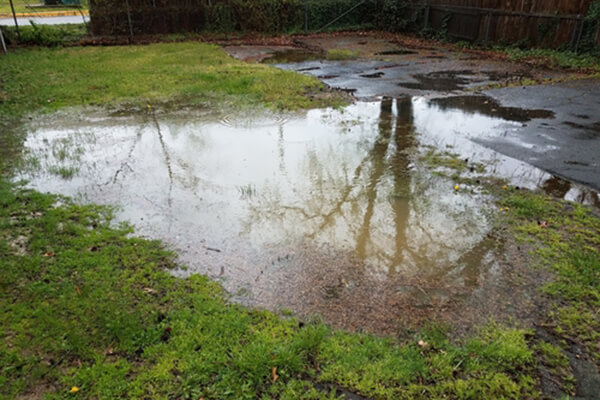
Standing water can be caused by many things: soil that doesn’t absorb water, grading issues, etc. Try these drainage solutions to keep your yard above water.
Keeping your lawn green and pristine is a matter of pride. So it can be upsetting to find a growing puddle of standing water in your yard. Not only is stagnant water unsightly, but it can also kill your grass, damage ornamental plants, compromise your home’s foundation, become a breeding ground for mosquitoes and be symptom of larger problems.
What causes water to accumulate on your lawn? What are the best methods of eliminating standing water? Here’s what homeowners need to know.
Causes of Standing Water
When stagnant water forms on your property, it can be a sign of either easily correctable habits or more fundamental design flaws.
Be careful of overwatering your lawn. If your home is equipped with an automatic sprinkler or irrigation system, you may need to make certain adjustments to address a problem with standing water. Try watering your lawn less frequently and/or for shorter periods of time.
If altering your gardening and maintenance habits doesn’t correct the issue, further investigation may be necessary. The following are common culprits in cases of standing water.
Grading. Lawns should be graded (or leveled) to ensure proper drainage. The slope should trend away from the house and direct run-off down towards the street, alleyway or storm sewer. If your landscaping doesn’t take the proper angle, water may collect on your lawn faster that it can drain. Improper drainage can also cause natural low spots in your yard to accumulate more and more water with each rainfall.
Thatch. Proper drainage also depends on your lawn’s permeability. A permeable lawn allows water to seep into the earth instead of collecting on the surface. If grass clippings or leaf litter clog on your lawn, they can prevent the soil from absorbing water as it would under normal conditions.
Soils. Hard, compact soils and heavy, sticky clay soils are also less absorbent and prevent surface water from seeping into the ground.
Hard subsoil. Hardpan is a thick layer of impervious subsoil. Hardpan can be naturally occurring, or it can be the result of construction equipment densely compacting yards and lawns which are then topped with a layer of topsoil, disguising the issue. Once water percolates down to the hardpan, it has nowhere else to go and begins pooling.
High water table. As rain seeps into the earth, it becomes groundwater. This groundwater forms a water table, a completely saturated level of subsurface soil and rock. In some instances, however, the water table can rise very close to the surface, creating waterlogged conditions.
Ways To Get Rid of Standing Water
Fortunately, you don’t have to live with standing water. Depending on the ultimate cause of your standing water problem, you can take immediate action to boost your lawn’s ability to shed water.
Re-grade. Consult with a professional landscaper on re-grading the terrain around your home. Be sure to request that the landscaper provide a survey of your lawn’s low-lying points, natural channels and drainage outlets.
De-thatch. You can remove heavy thatch using a dethatcher, vertical mower, or even a simple lawn rake. Once you’ve removed the plant debris, pierce the turf with a garden fork or a lawn aerator. The small holes you make should be at least 4 inches deep and spaced 2 inches apart. Aerated soil is not only soil that drains properly — it’s also healthier soil.
Break it up. In order to make your lawn more amenable to water absorption, work organic matter into your soil. Garden compost, leaf mold and manure will all open the soil up and create more minute channels through which water can escape.
Dig. For hardpan problems, a shovel may be the best solution. If the hardpan is less than 2 feet thick, wait for a dry spell and then dig up as much as you can. If you can’t break up the hardpan yourself, consult with a professional contractor who specializes in drilling through densely packed subsoil.
Make accommodations. A high water table is a much more difficult issue to address. Instead, it’s a fact of life that you will likely have to work around. However, you can still improve drainage by increasing the depth of your lawn borders. You can also add layers of soil to create raised beds. Finally, you can landscape using more shallow-rooted plants capable of surviving wet conditions.
Install a French drain. A French drain (also known as a curtain drain) is actually a comprehensive drainage system made from rather simple materials. A graded trench directs the flow of water away from the home. The trench is then filled in with gravel, which lets gravity do the work of channeling the water into a perforated pipe that sits at the trench’s base.
Don’t let standing water keep you and your family from enjoying the outdoor areas around your home. By identifying the cause of your drainage problem and relying on good common sense, you can ensure that gray clouds don’t linger even after the storms have passed.
Source: https://www.ahs.com/home-matters/lawn-garden/how-to-rid-standing-water-in-yard
